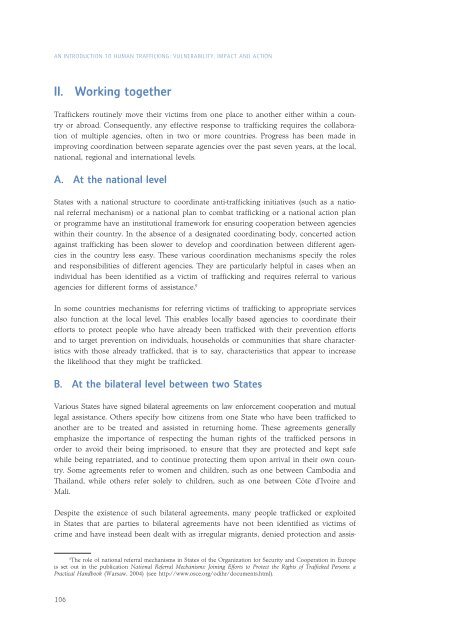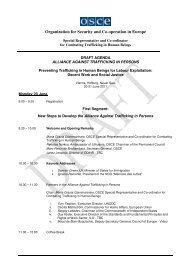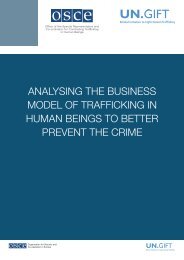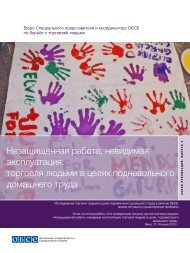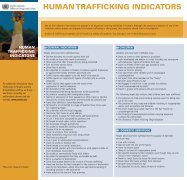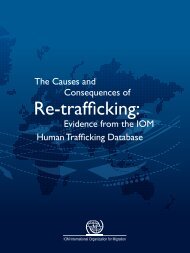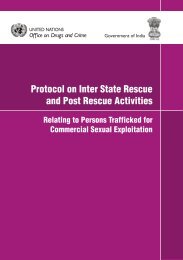An Introduction to Human Trafficking - United Nations Office on ...
An Introduction to Human Trafficking - United Nations Office on ...
An Introduction to Human Trafficking - United Nations Office on ...
Create successful ePaper yourself
Turn your PDF publications into a flip-book with our unique Google optimized e-Paper software.
AN INTRODUCTION TO HUMAN TRAFFICKING: VULNERABILITY, IMPACT AND ACTION<br />
II.—Working <str<strong>on</strong>g>to</str<strong>on</strong>g>gether<br />
Traffickers routinely move their victims from <strong>on</strong>e place <str<strong>on</strong>g>to</str<strong>on</strong>g> another either within a country<br />
or abroad. C<strong>on</strong>sequently, any effective resp<strong>on</strong>se <str<strong>on</strong>g>to</str<strong>on</strong>g> trafficking requires the collaborati<strong>on</strong><br />
of multiple agencies, often in two or more countries. Progress has been made in<br />
improving coordinati<strong>on</strong> between separate agencies over the past seven years, at the local,<br />
nati<strong>on</strong>al, regi<strong>on</strong>al and internati<strong>on</strong>al levels.<br />
A.—At the nati<strong>on</strong>al level<br />
States with a nati<strong>on</strong>al structure <str<strong>on</strong>g>to</str<strong>on</strong>g> coordinate anti-trafficking initiatives (such as a nati<strong>on</strong>al<br />
referral mechanism) or a nati<strong>on</strong>al plan <str<strong>on</strong>g>to</str<strong>on</strong>g> combat trafficking or a nati<strong>on</strong>al acti<strong>on</strong> plan<br />
or programme have an instituti<strong>on</strong>al framework for ensuring cooperati<strong>on</strong> between agencies<br />
within their country. In the absence of a designated coordinating body, c<strong>on</strong>certed acti<strong>on</strong><br />
against trafficking has been slower <str<strong>on</strong>g>to</str<strong>on</strong>g> develop and coordinati<strong>on</strong> between different agencies<br />
in the country less easy. These various coordinati<strong>on</strong> mechanisms specify the roles<br />
and resp<strong>on</strong>sibilities of different agencies. They are particularly helpful in cases when an<br />
individual has been identified as a victim of trafficking and requires referral <str<strong>on</strong>g>to</str<strong>on</strong>g> various<br />
agencies for different forms of assistance. 9<br />
In some countries mechanisms for referring victims of trafficking <str<strong>on</strong>g>to</str<strong>on</strong>g> appropriate services<br />
also functi<strong>on</strong> at the local level. This enables locally based agencies <str<strong>on</strong>g>to</str<strong>on</strong>g> coordinate their<br />
efforts <str<strong>on</strong>g>to</str<strong>on</strong>g> protect people who have already been trafficked with their preventi<strong>on</strong> efforts<br />
and <str<strong>on</strong>g>to</str<strong>on</strong>g> target preventi<strong>on</strong> <strong>on</strong> individuals, households or communities that share characteristics<br />
with those already trafficked, that is <str<strong>on</strong>g>to</str<strong>on</strong>g> say, characteristics that appear <str<strong>on</strong>g>to</str<strong>on</strong>g> increase<br />
the likelihood that they might be trafficked.<br />
B.—At the bilateral level between two States<br />
Various States have signed bilateral agreements <strong>on</strong> law enforcement cooperati<strong>on</strong> and mutual<br />
legal assistance. Others specify how citizens from <strong>on</strong>e State who have been trafficked <str<strong>on</strong>g>to</str<strong>on</strong>g><br />
another are <str<strong>on</strong>g>to</str<strong>on</strong>g> be treated and assisted in returning home. These agreements generally<br />
emphasize the importance of respecting the human rights of the trafficked pers<strong>on</strong>s in<br />
order <str<strong>on</strong>g>to</str<strong>on</strong>g> avoid their being impris<strong>on</strong>ed, <str<strong>on</strong>g>to</str<strong>on</strong>g> ensure that they are protected and kept safe<br />
while being repatriated, and <str<strong>on</strong>g>to</str<strong>on</strong>g> c<strong>on</strong>tinue protecting them up<strong>on</strong> arrival in their own country.<br />
Some agreements refer <str<strong>on</strong>g>to</str<strong>on</strong>g> women and children, such as <strong>on</strong>e between Cambodia and<br />
Thailand, while others refer solely <str<strong>on</strong>g>to</str<strong>on</strong>g> children, such as <strong>on</strong>e between Côte d’Ivoire and<br />
Mali.<br />
Despite the existence of such bilateral agreements, many people trafficked or exploited<br />
in States that are parties <str<strong>on</strong>g>to</str<strong>on</strong>g> bilateral agreements have not been identified as victims of<br />
crime and have instead been dealt with as irregular migrants, denied protecti<strong>on</strong> and assis-<br />
9<br />
The role of nati<strong>on</strong>al referral mechanisms in States of the Organizati<strong>on</strong> for Security and Cooperati<strong>on</strong> in Europe<br />
is set out in the publicati<strong>on</strong> Nati<strong>on</strong>al Referral Mechanisms: Joining Efforts <str<strong>on</strong>g>to</str<strong>on</strong>g> Protect the Rights of Trafficked Pers<strong>on</strong>s: a<br />
Practical Handbook (Warsaw, 2004) (see http://www.osce.org/odihr/documents.html).<br />
106


